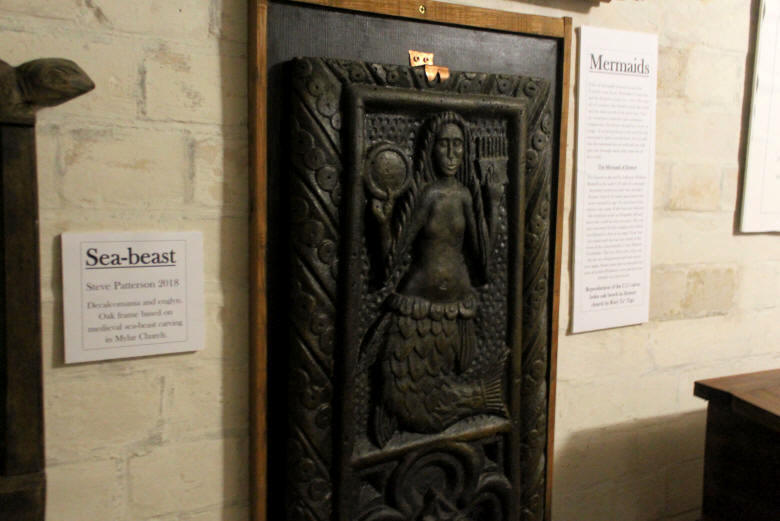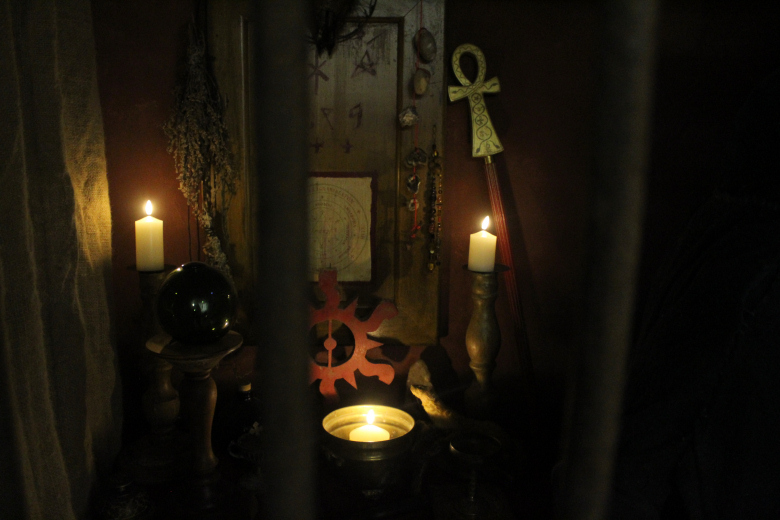|
|
| home | exhibitions | interviews | features | profiles | webprojects | archive |
|
Steve Patterson on The Museum of Magic and Folklore West Cornwall Interview Rupert White
This museum feels like a very personal project, right down to the ambient sound which you recorded yourself. What was its origin, and how long have you been working on the idea??
It's been an idea for a long time. I've
been involved with the Museum of Witchcraft and Magic in Boscastle
since the mid 90s, and before that I'd worked in various museums. I
started thinking about creating a museum in Falmouth or West
Cornwall before the lockdown. I started looking at premises, and
there were a number that I found, but they all fell through.
More recently some friends were setting up a venue - a bar - at The Cornish Bank and below it are these old 18th century vaults which they were using as a storeroom. I put the idea of the museum to them, and they were keen. So I now have this fantastic venue in Falmouth in these ancient vaults, with the street above our heads. And I've been able to air my collection which has been living in a shed for some years!
Do you want to say something more
about the collection? Some of it is artwork by others, some art work
by yourself, and there are lots of found objects. It's an
interesting mixture.
As soon as you look at the nature of artefacts one starts going down an existential rabbit hole. But I'm interested in the interface between art, magic, folklore and the landscape. So here, in the entrance, we have a section called 'The Year's Round' featuring folk festivals, like the Obby Oss. It was witnessing the Padstow Obby Oss in the 80s that really acquainted me with Cornwall. These are very powerful events. They work on lots of different levels. On an outer level they're about festivities and partying, but they're also about identity, and at a deeper level about our relationship to the land and the passing of the seasons. These things are wound together. It's very evident when you're there. I'm very privileged to have one of Tim Shaw's sculptures here, of the Oss before the crucifix. This is something he witnessed.
Of course, because
the Oss goes into the church in Padstow...
Apparently it doesn't now. The present
vicar isn't keen on it. But Tim witnessed it a few years ago and
found it a very moving experience.
This section, The Year's Round, like the other sections has its own lovely wooden sign, which you hand-carved yourself. I also carved the signs at the museum in Boscastle.
Really? I didn't realise. Coming to the main room next door, there are some interesting pieces by Rory Te Tigo, including a recreation of the mermaid of Zennor (photo above). Its actually made of stone, cement I think, that I found a way to re-colour so it looks like wood. Rory also designed the ankh-staff.
I must ask you about the witches' cradle, as it's the biggest exhibit in the museum (below), and it includes some sprigs of magical mugwort which I know you originally collected from Cecil Williamson's garden. This was an exhibit that was in the Museum of Witchcraft in Boscastle in the 60s. When Graham King took over the museum in the 90s he took out some of the old tableaux, including the old witches' cradle which ended up in a skip. I saved all the long pieces of metal so that one day I could reconstruct it, and with the help of a local blacksmith, Lisa Wisden I managed to do so.
There are some B&W photos of the
original witches' cradle tableau from the 60s...
Yes. There are two which I worked from to
reconstruct it.
No one really knows where he got it from, or the story behind it, but Cecil Williamson said he was in contact with local traditional witches. People have been quite cynical about this in the past, but time and again he's been proven right and I'm sure that one day the origin will turn up. But it is a very peculiar and eerie piece.
I know Simon Costin director of the
MoWM has also kindly given you some of the old cabinets from the
museum in Boscastle, but are there other objects here connected to
the Boscastle collection?
There are all sorts of odds and ends, scattered amidst the collection. Two interesting examples that were also thrown out at the time of the redesign are some wooden pieces that are symbols for the planets (eg red object in photo below). I think they came from a magic circle Cecil Williamson designed on the Isle of Man. History is a fickle thing. No one at the time knew whether any of this stuff was going to be of interest thirty years later. When Graham took over it was a small provincial museum and there was very little interest in the old craft, but this has grown much more in recent years.
Speaking of the old craft I spotted quite a few nice pieces by Gemma Gary, and her coven, including Kasek Nos, the oss she made with Jane Cox. Gemma was inspired by Doc Shiels, so its good to see you also have a 'Doc Shiels corner'. Doc has such strong links with the local area. Morgawr, his sea monster, will be forever linked with Falmouth Bay. In Falmouth in the 70s and 80s there was an interesting scene. Peter Redgrove the poet was at the art college, with his strange mix of tantra, surrealism, Jungian psychology and witchcraft, and Tony 'Doc' Shiels was around, and a number of other people. Visitors to this museum have said there is a vibe here which reminds them of those days, which I take as a compliment. Tony Shiels is certainly an interesting character....
Yes. Another
bit of interesting local knowledge, are the hexafoil-type markings
in Mylor Church which is not far from here, which you have
photographed and included in the apotropaic magic section.
People have denied they exist, but there are lots of them in the stonework and they're quite easy to find if you know what you're looking for.
What has the response been to the
museum??
Really good. It's only two rooms but people spend between 20 minutes and an hour in here. Which is a result. I've had a lot of holiday makers who are really engaging with the material. I think the space of a museum is really important, and the idea of a museum as a transformative space. People are coming in, staying for up to an hour and walking out with eyes like saucers!
What are your future plans for it?
I'm hoping to find more permanent
premises, that will include an open access library.
I can imagine it will be successful.
There is a hankering for this
kind of material, which is not well covered elsewhere in Cornwall,
other than in Boscastle.
We are the opposite corner of Cornwall to Boscastle, and more accessible to people down this end. And you're right it is underrepresented. A lot of museums have folkloric artefacts in there, but so often they're badly labelled, or mislabelled, or out of context.
And there's still a taboo element
about some of this material, so it gets hidden away.
There is a still a prejudice. There's cultural embarrassment. It's seen as part of an embarrassing, ignorant past that we don't like talking about. Also conceptually people find it difficult to place folkloric magical material. What do you do with it?? We spoke earlier about the interface between art and magic and folklore. A lot of the interest recently is more from the artistic, creative community.
Agreed. There's
been a real revival of interest in the last five or ten years, and
artists locally are responding more to what they find around them.
To me it seems a very obvious crossover...
Steve Patterson is the author of 'Cecil Williamson's Book of Witchcraft' and 'Spells from the Wise Woman's Cottage'. www.stevepattersonantiquarian.com . see 'exhibitions' for more images. 20.8.21 |
|
|




